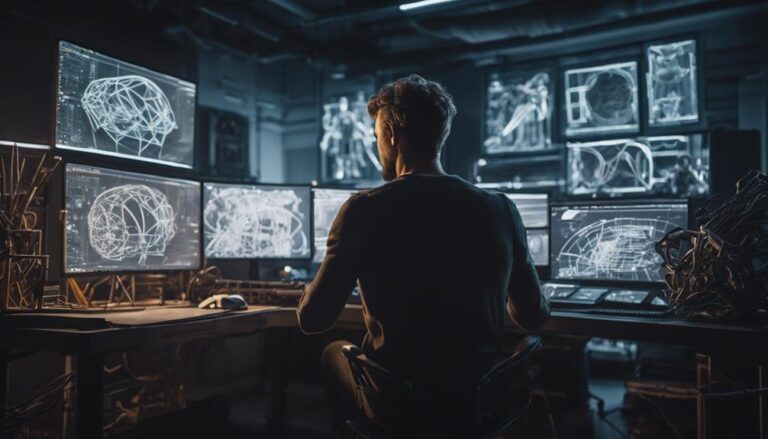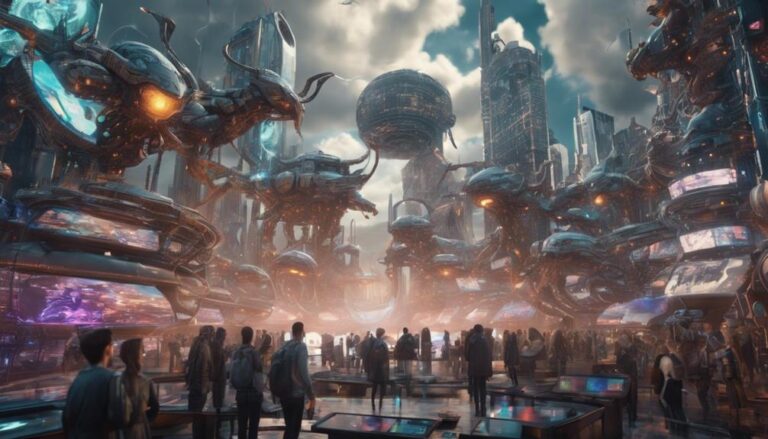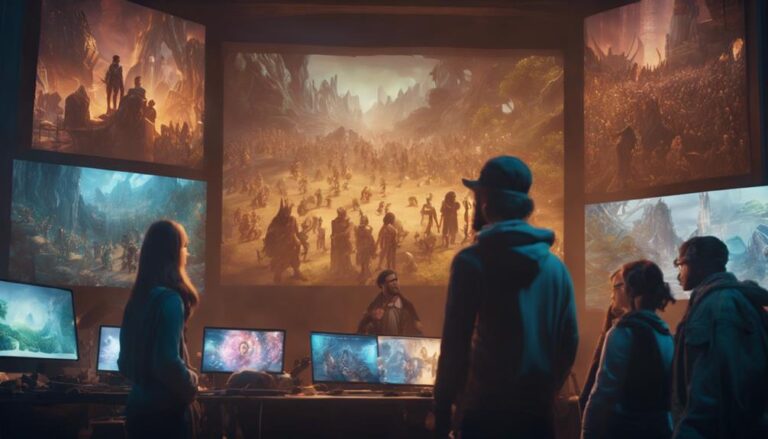2D Animation Production Pipeline Management
You're about to initiate a 2D animation project, and managing your production pipeline is vital for success. Start by setting up a clear framework, defining project parameters, and allocating resources effectively. Organize your assets with a logical folder structure and naming conventions. In pre-production, establish your visual style, develop characters, and create a detailed storyboard. During production, refine your animation, incorporate feedback, and stay on track. Implement quality control checks, identify areas for improvement, and verify your final product meets required standards. Now that you have a solid foundation, you're ready to take your pipeline to the next level.
Key Takeaways
- Establish a clear pipeline framework to optimize project scope, goals, and timelines for efficient production.
- Allocate resources effectively by identifying task dependencies, potential bottlenecks, and realistic timelines for each task.
- Develop a system for asset management and organization, including file naming conventions and a logical project folder structure.
- Implement quality control checks throughout production to ensure the animation meets required quality and technical standards.
- Conduct thorough final reviews to verify the project meets required standards, is error-free, and ready for delivery.
Setting Up the Pipeline Framework
Establish a clear understanding of your project's scope, goals, and timelines to set up an efficient pipeline framework that suits your 2D animation production needs. This foundation is vital in ensuring a smooth workflow and minimizing potential roadblocks.
By defining your project's parameters, you'll be able to identify areas where Pipeline Optimization can be applied, streamlining your process and reducing production time.
When customizing your framework, consider the specific requirements of your project. This Framework Customization will enable you to allocate resources effectively, prioritize tasks, and establish a logical sequence of events.
A well-structured pipeline framework will also facilitate collaboration among team members, ensuring everyone is on the same page.
To achieve peak efficiency, break down your project into manageable chunks, and establish clear dependencies between tasks.
This will enable you to identify potential bottlenecks and make adjustments accordingly.
Task Assignment and Scheduling
With your pipeline framework in place, you can now plunge into task assignment and scheduling, where you'll allocate specific responsibilities to team members and create a realistic timeline for each task to guarantee a seamless workflow. This critical step certifies that every team member knows their role and deadlines, preventing confusion and delays.
When assigning tasks, consider team capacity and resource allocation. You want to verify that each team member has a manageable workload and the necessary resources to complete their tasks on time. Overloading team members can lead to burnout and mistakes, while underutilizing them can result in delays.
Task dependencies: Identify tasks that rely on the completion of others to avoid bottlenecks and delays.
Resource constraints: Allocate resources effectively to avoid shortages or overallocation.
Buffer time: Build in some extra time for unexpected setbacks or changes.
Asset Management and Organization
As you set up your 2D animation production pipeline, you'll need to develop a system to keep track of your project's assets, including characters, props, and backgrounds.
You'll want to establish clear file naming conventions and a logical project folder structure to guarantee that everyone on your team can easily find and access the assets they need.
Asset Tracking Systems
You'll need to set up an asset tracking system to keep tabs on the hundreds of files, images, and animations that will accumulate throughout the production process. This system will help you keep track of every asset, from concept art to final renders, and guarantee that your team can access and collaborate on them efficiently.
When choosing an asset tracking system, consider the following key features:
- Digital Repositories: A centralized hub where all assets are stored, making it easy to locate and access files.
- Cloud Collaboration: Real-time collaboration tools that allow team members to work together on assets simultaneously, regardless of location.
- Version Control: Automatic tracking of asset versions, certifying that everyone is working with the most up-to-date files.
File Naming Conventions
Establishing a consistent file naming convention is crucial to maintaining organization and facilitating asset management throughout the 2D animation production pipeline. You'll want to create a system that is easy to understand and follow, ensuring that all team members can quickly locate and identify files. A well-structured file naming convention will help you navigate your file hierarchy with ease, saving time and reducing frustration.
Guidelines for examination:
| File Component | Description |
|---|---|
| Project Code | Unique identifier for the project (e.g. 'PRJ001') |
| Asset Type | Specifies the type of asset (e.g. 'char', 'prop', 'bg') |
| Asset Name | Descriptive name of the asset (e.g. 'main_character', 'tree_prop', 'city_background') |
| Version Number | Indicates the version of the asset (e.g. 'v01', 'v02', etc.) |
Project Folder Structure
Organize your project's asset files into a logical folder structure, which will enable you to efficiently store, retrieve, and manage assets throughout the 2D animation production pipeline. A well-planned folder structure is essential for a smooth production workflow. It helps you to quickly locate files, collaborate with team members, and maintain version control.
Create a directory hierarchy that mirrors the production stages, such as script, design, assets, animation, lighting, and compositing. Within each stage, create subfolders for specific assets, like character designs, backgrounds, or props. Use folder templates to guarantee consistency across the project.
Some key benefits of a logical folder structure include:
- Easy file retrieval and management
- Reduced errors and miscommunication
- Improved collaboration and version control
- Faster project completion and delivery
Design and Storyboarding Process
As you plunge into the design and storyboarding process, define the visual style and tone of your animation by creating concept art that captures the essence of your story.
This is where you'll establish the overall aesthetic, from color palettes to character designs.
You'll also start developing your characters, giving them unique personalities, backstories, and motivations.
This character development will help inform their actions and interactions throughout the animation.
Next, you'll move on to visual scripting, where you'll break down the story into individual shots and sequences.
This is vital in planning the pacing, camera angles, and overall flow of your animation.
You'll create a series of thumbnails or rough sketches that represent each shot, allowing you to visualize the entire sequence and make any necessary adjustments.
With your visual script in place, you're ready to create a more detailed storyboard.
This is where you'll add more context to each shot, including dialogue, camera movements, and character actions.
Your storyboard should provide a clear roadmap for the entire production, ensuring everyone involved is on the same page.
Animation Production and Testing
Your animation production begins with creating a rough cut, where you'll start building your scenes and shots using the approved storyboard as a guide. This is where you'll bring your characters to life, block out the action, and set the pacing for your animation.
As you work through the rough cut, you'll start to refine your animation, making adjustments to timing, spacing, and movement.
You'll also start to incorporate advanced techniques.
- Motion capture: using special suits and cameras to record realistic character movements
- Virtual cinematography: using software to create virtual cameras and lenses, allowing for greater control over your shot composition
- 3D modeling and texturing: adding depth and detail to your characters and environments
These techniques will help you create a more immersive and engaging animation.
As you continue to refine your work, you'll start to see your vision take shape. Remember to stay organized, keep track of your progress, and make adjustments as needed to guarantee your animation stays on track.
Quality Control and Assurance
Now that your animation is taking shape, you'll need to get cracking on quality control and assurance to certify it meets the desired standards. This vital step guarantees your animation meets the required quality metrics, and doing it correctly is paramount. You'll need to identify areas that require improvement and implement changes to guarantee your animation is error-free and polished.
To streamline the quality control process, consider using automation tools to detect and fix common issues. These tools can help you identify problems with color, lighting, and animation timing, saving you time and effort.
| Quality Metrics | Automation Tools | Manual Checks |
|---|---|---|
| Color accuracy | Color grading software | Visual inspection |
| Animation timing | Animation testing tools | Review by lead animator |
| Audio quality | Audio editing software | Listening test |
| Storyboard consistency | Storyboard review software | Review by director |
Final Review and Delivery
You've perfected your animation's quality, and it's time to put the final stamp of approval on your project by conducting a thorough review before delivering it to the client or audience.
This final review is pivotal in verifying that your project meets the required standards and is free from errors.
To guarantee a smooth delivery, create a final checklist that covers all aspects of the project, including visuals, sound, and overall flow.
Review the animation against the original brief and confirm it meets all the requirements.
Check for any technical issues, such as formatting, resolution, and compatibility.
Verify that all necessary files and documents are included and organized correctly.
Frequently Asked Questions
How Do I Handle Unexpected Changes in Project Scope or Timeline?
When unexpected changes hit, you'll need to assess the impact on scope and timeline. Implement change management strategies to mitigate scope creep, prioritize tasks, and renegotiate deadlines to guarantee a smooth project flow.
What Tools Are Best for Remote Team Collaboration and Communication?
You'll find virtual whiteboards like Mural or Google Jamboard ideal for brainstorming sessions, while cloud-based workflows like Asana, Trello, or Monday.com help you track progress and collaborate seamlessly with your remote team.
Can I Use Agile Methodologies in a 3D Animation Production Pipeline?
You can definitely adopt Agile methodologies, breaking down complex tasks into manageable iterations. Start by identifying goals, prioritizing tasks, and allocating resources for each iteration, ensuring flexible adaptation to changing project requirements.
How Do I Balance Quality With Tight Deadlines and Budgets?
When balancing quality with tight deadlines and budgets, you'll need to conduct a thorough risk assessment to identify potential roadblocks, then allocate resources strategically to mitigate those risks and guarantee deliverables meet expectations.
What Metrics Should I Track to Measure Pipeline Efficiency and Productivity?
To measure pipeline efficiency and productivity, you should track process metrics like cycle time, throughput, and lead time. Conduct workflow analysis to identify bottlenecks, then optimize tasks and resource allocation to boost overall performance.
Conclusion
You've successfully set up a 2D animation production pipeline, assigning tasks, managing assets, and guiding your project from design to delivery.
By following this structured approach, you've guaranteed a high-quality final product, meeting deadlines and staying within budget.
With a well-organized pipeline, you're now equipped to tackle complex projects, collaborate efficiently, and deliver engaging animations that captivate your audience.





